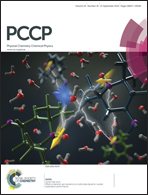Towards understanding the color change of 1-butyl-3-methylimidazolium bis(trifluoromethylsulfonyl)imide during gamma irradiation: an experimental and theoretical study†
Abstract
The application of room-temperature ionic liquids (RTILs) in nuclear spent fuel recycling requires a comprehensive knowledge of radiation effects on RTILs. Although preliminary studies indicate a relatively high radiation stability of RTILs, little attention is paid to the color change of RTILs, an obvious phenomenon of RTILs during irradiation. In this paper, we have investigated radiation-induced darkening and decoloration of 1-butyl-3-methylimidazolium bis(trifluoromethylsulfonyl)imide ([BMIm][NTf2]), an ionic liquid representing the most popular class of RTILs, by means of UV-Vis analysis and time-dependent density functional theory calculations. Based on the experimental and computational results, it is proposed that the color change of [BMIm][NTf2] upon irradiation originates from the formation of double bonds in the aliphatic chains of pristine organic cations (or radiolytic products of RTILs) and various associated species containing these “double-bond products”. This work sheds light on the understanding of the radiation-induced color change of RTILs.


 Please wait while we load your content...
Please wait while we load your content...